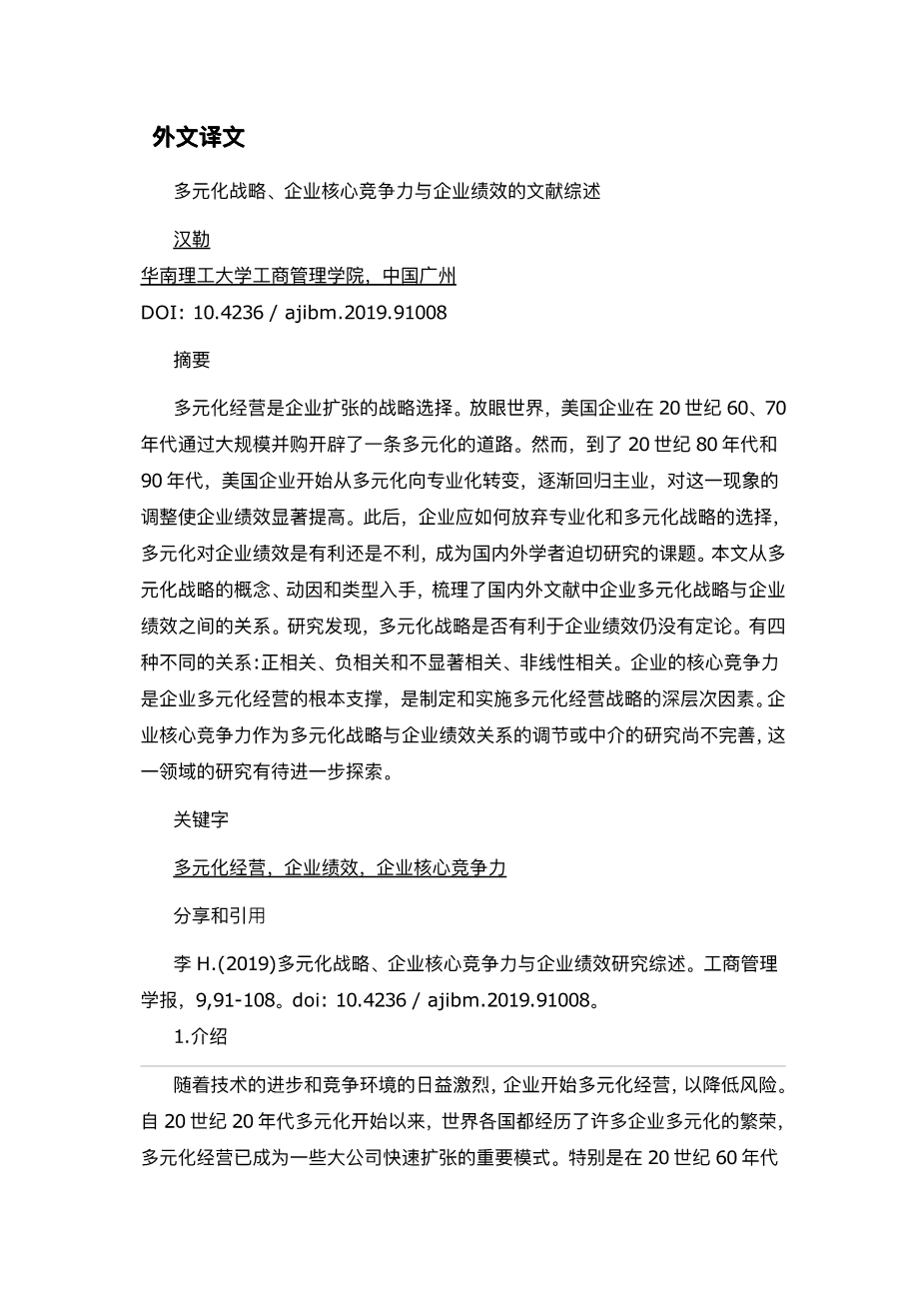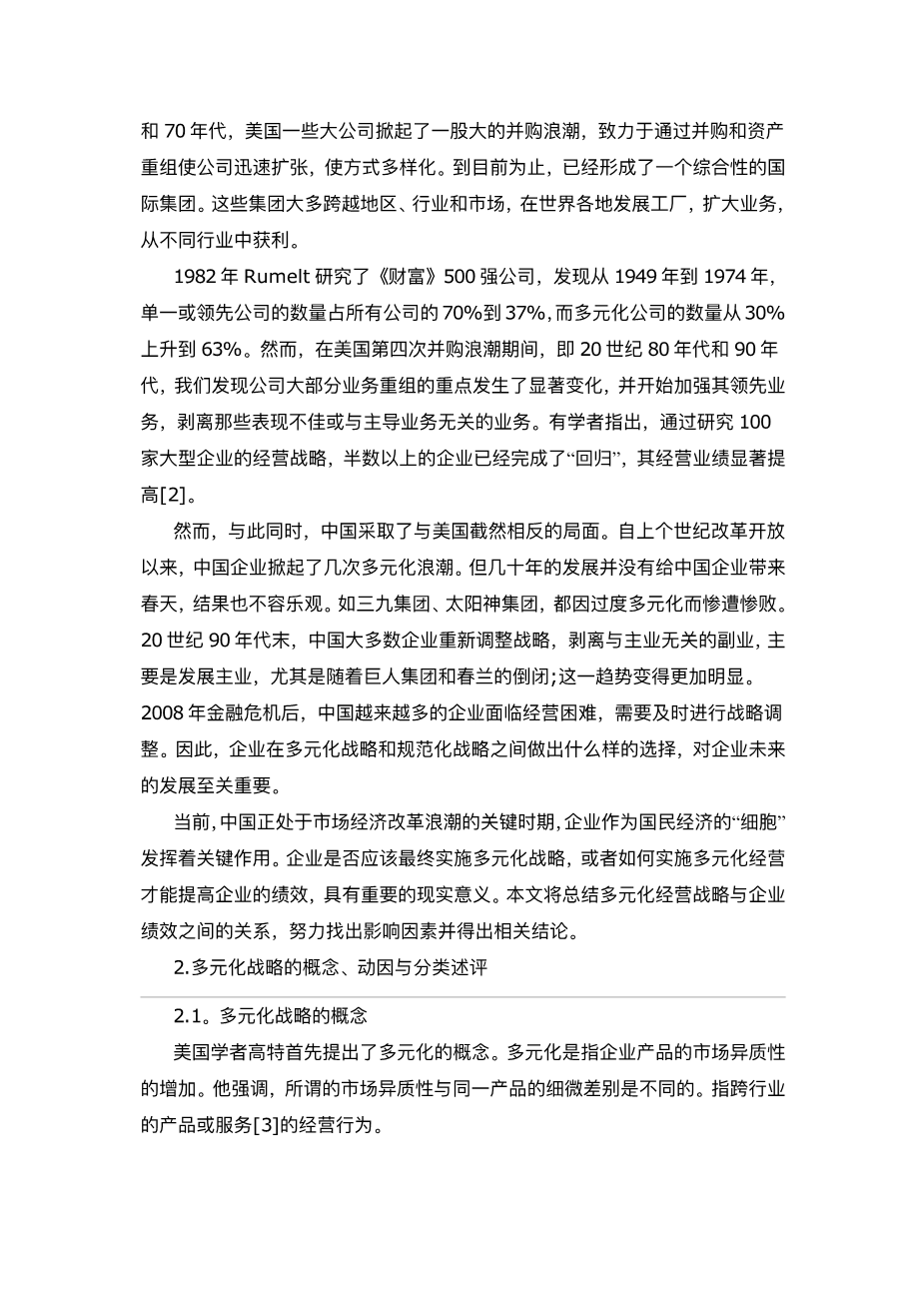Literature Review on Diversification Strategy, Enterprise Core Competence and Enterprise Performance
Han Le
School of Business Administration, South China University of Technology, Guangzhou, China.
DOI: 10.4236/ajibm.2019.91008
Abstract
Diversification is a strategic choice for enterprise expansion. Looking at the world, American companies in the 1960s and 1970s opened up a diversified path through large-scale mergers and acquisitions. However, by the 1980s and 1990s, American companies began to change from diversification to specialization, gradually returning to their main business, and the adjustment of this phenomenon made the performance of those companies significantly improved. Since then, how should companies abandon the choice of specialization and diversification strategy, and whether diversification is beneficial or unfavorable to corporate performance have become topicsthat domestic and foreign scholars are eager to study. Based on the concept, motivation and type of diversification strategy, this paper sorts out the relationship between corporate diversification strategy and corporate performance in domestic and foreign literatures. It is found that there is still no definitive answer to whether diversification strategy is beneficial to corporate performance. There are four different relationships: positive correlation, negative correlation and no significant correlation, and nonlinear correlation. The core competence of an enterprise is the fundamental support of diversified business operations and a deep-seated factor in the formulation and implementation of diversified business strategies. Research on the core competence of enterprises as a regulation or mediator of the relationship between diversification strategy and firm performance is still not perfect, and research in this field needs to be further explored.
Keywords Diversification, Corporate Performance, Corporate Core Competence
Share and Cite:
Le, H. (2019) Literature Review on Diversification Strategy, Enterprise Core Competence and Enterprise Performance. American Journal of Industrial and Business Management, 9, 91-108. doi: 10.4236/ajibm.2019.91008.
1. Introduction
With the advancement of technology and the increasingly fierce competitive environment, companies have begun to diversify their operations in order to reduce risks. Since the beginning of diversification in the 1920s, countries around the world have experienced many corporate diversification booms, and diversified operations have become an important model for the rapid expansion of some large companies. Especially in the 1960s and 1970s, some large companies in the United States set off a wave of big mergers and acquisitions, committed to rapidly expanding the company and diversifying the way through mergers and acquisitions and asset restructuring. So far, a comprehensive international group has emerged. Most of these groups have crossed regions, industries and markets, developing factories around the world, expanding their businesses, and making profits from various industries.
In 1982, Rumelt studied Fortune 500 companies and found that from 1949 to 1974, the number of single or leading companies accounted from 70% to 37% of all companies, while the number of diversified companies rose from 30% to 63% [1] . However, during the fourth wave of mergers and acquisitions in the United States, that is, in the 1980s and 1990s, we found that most of the companyrsquo;s business restructuring priorities have changed significantly, and began to strengthen its leading business, which has divested those businesses that are not performing well or are not related to the dominant business. Some scholars have pointed out that by studying the business strategies of 100 large enterprises, more than half of the enterprises have completed “returning” and their business performance has been significantly improved [2] .
At the same time, however, China has taken a diametrically opposite situation with the United States. Since the reform and opening up in the last century, Chinese companies have set off several waves of diversification. But decades of development have not brought spring to Chinese companies, and the results are not optimistic. For example, the Sanjiu Group and the Sun God Group have been fiercely defeated due to excessive diversification. In the late 1990s, most of Chinarsquo;s enterprises re-adjusted their strategies and divested their side businesses that were not related to the main business, mainly to develop their main business, especially with the collapse of the Giant Group and Chunlan; this trend became more apparent. After the financial crisis in 2008, more and more enterprises in China are facing operational difficulties and need to make strategic adjustments in a timely manner. Therefore, what choices companies make between diversification strategies and normalization strategies is very important for the future development of enterprises.
At present, China is in the critical period of the wave of market economy reform, and enterprises play a key role as the “cell” of the national economy. Whether enterprises should implement diversification strategies in the end or how to implement diversified operations can improve the performance of enterprises is of great practical significance. This paper will summarize the relationship between diversified business strategy and corporate performance, and strive to find out the influencing factors and draw relevant conclusions.
2. The Review of the Concept, Motivation and Classification of Diversification Strategies
2.1. The Concept of Diversification Strategy
Gort, an American scholar, first proposed the concept of diversification. Diversification refers to the increase of market heterogeneity of enterprise products. He emphasized that the so-called market heterogeneity is different from the nuance of the sam
剩余内容已隐藏,支付完成后下载完整资料


英语译文共 13 页,剩余内容已隐藏,支付完成后下载完整资料
资料编号:[589311],资料为PDF文档或Word文档,PDF文档可免费转换为Word


